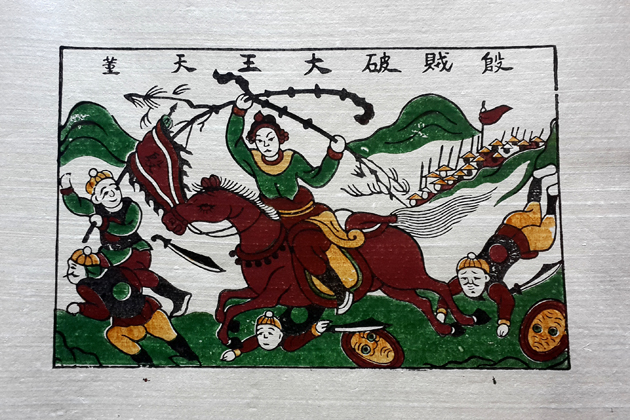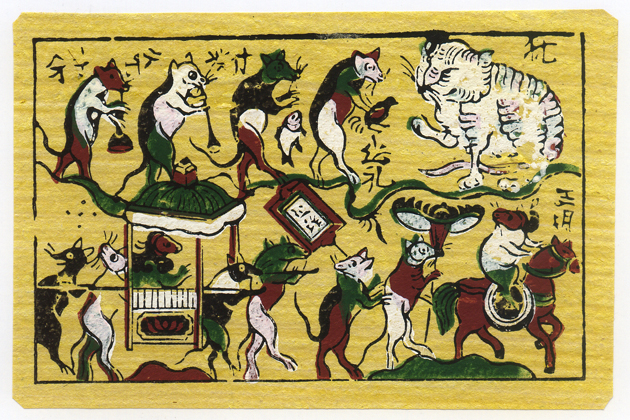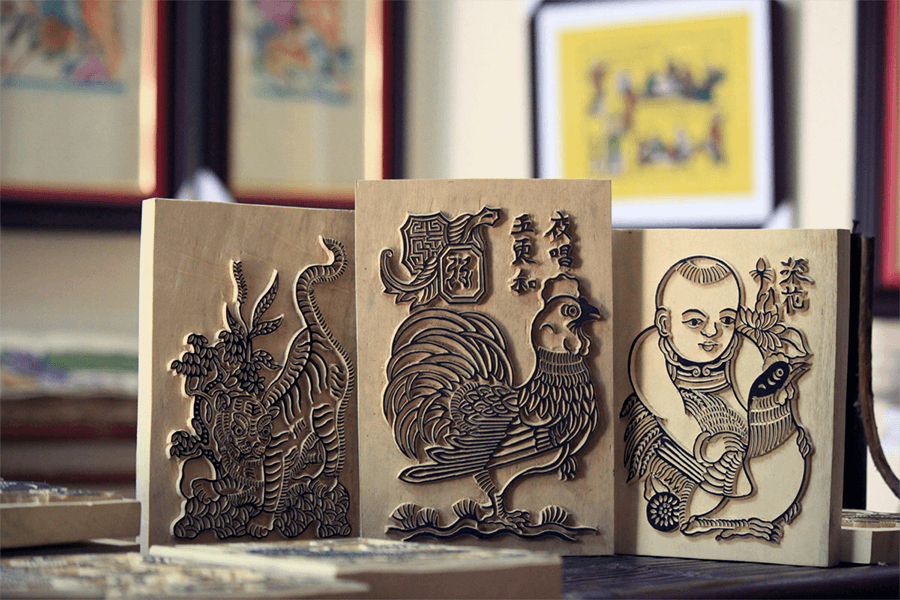Farmers in Ho Village in Bac Ninh Province north of Hanoi have a traditional secondary occupation: drawing pictures and printing them on the occasion of Tet. These brightly colored pictures are drawn, engraved on wood, and printed with rudimentary means on home-made paper coated with white oyster-shell powder. They entrance both old and young. To understand the success of these people's artists, one must witness the scene of peasants enthusiastically crowding around a picture vendor - usually a woman - in a special rural market held on the approach of Tet. Every family wants to adorn its home with some of these pictures. There is a choice between The Sow and Her Piglets, The Hen and Her Chicks, Jealousy, Master Toad, The Rat's Wedding, Picking Coconuts, and many others. These pictures strike a fresh note inside dark thatch houses by bringing a good wish, expressing a dream, or illustrating a moral precept.

The art of Ho Village gradually decayed under French domination because of competition from foreign production and the colonists' policy of art assimilation. The sale of drawings of Ho Village became limited to small markets in remote rural areas instead of reaching a large urban clientele. When the Resistance War broke out, artists packed away their paints and brushes, took up rifles, or joined groups of evacuees. Many of the wooden engraving plates were burned, chopped up as firewood, or thrown away by the colonialist troops in their raids on Bac Ninh Province.
However, since the liberation of northern Vietnam in 1954 and especially since the unification of the country in 1975, this art in Ho Village has revived, and new groups of artists have formed in other places. The pictures of Ho Village serve as an important source for scholars studying the history of Vietnamese traditional art. Before the 1945 August Revolution, only a few artists - Nguyen Do Cung in particular - took an interest in popular sources. However, since the Revolution, Vietnamese artists have made test drawings modeled on the pictures of Ho Village.

Painters Tran Van Can and Ta Thuc Binh made posters to publicize the fight against illiteracy, to encourage enrollment in the army, and to affirm the struggle for increased production. In so doing, they were inspired by the methods of the peasants of Ho Village, whose drawings are all the more valuable since they are the comparable source of Vietnamese folk that has survived. True, these pictures have not yet gone beyond native subjects and suffer from an obvious lack of technique. However, like folk songs, dances, popular poems, and theatre, they testify to the continuity of art speaking to and emanating from ordinary people. Such pictures as The Hen and Her Chicks and The Sow and Her Piglets with their lively strokes show an image of prosperity. Others like The Trung Sisters, Thach Sanh, and Thuy Kieu praise patriotism and fidelity to moral precepts.
In addition, a whole category of satirical subjects denounces the bad habits and manners of the ruling classes. Master Toad makes fun of the scholars who recited sentences all day that they had learned by heart. The Rat's Wedding mocks the ceremonious and complicated rites of the elite of the time. In this picture, the cat calmly waiting for the fish offered by the rats embodies official corruption. Jealousy shows a husband and his second wife threatened by his first wife as a humorous attack against polygamy. Picking Coconuts is a gay and bold drawing. A woman peasant reveals part of her thighs as she pulls up her skirt to gather coconuts; it is a successful illustration of popular songs and verses deriding the hypocritical "austerity" of official morals. All these very simple pictures breathe optimism as they reflect the people's daily life and the special features of the peasants' outlook. It is courageous to attack such sacrosanct social strata as royalty, mandarins, and scholars. These pictures reflect the typical characteristics of Vietnamese laborers, who can always find an appropriate way to ridicule their oppressors. From a technical point of view, the artists use simple colors. Green, red, and yellow dominate. In order to make the thatch cottages brighter, the artists exchange actual colors for more lively ones. Painters trained in modern schools are developing and popularizing this art of the people, helping traditional artists improve their technique and find new subjects. In this way, the pictures created by the peasants of H6 Village may continue to flourish.



